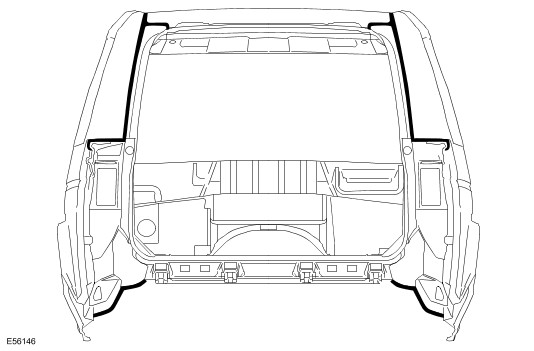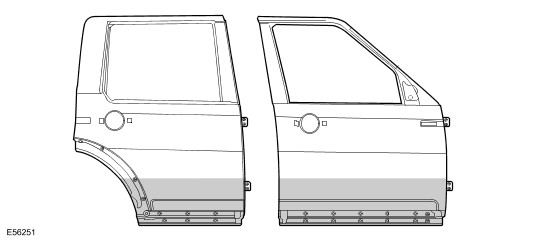 : Ensure that suspension units, wheels, tires, power unit, drive shafts,
exhaust and brakes (including all mounting points) are shielded prior to
application of fresh underbody sealer.
: Ensure that suspension units, wheels, tires, power unit, drive shafts,
exhaust and brakes (including all mounting points) are shielded prior to
application of fresh underbody sealer. | : | Dec 21, 2006 |
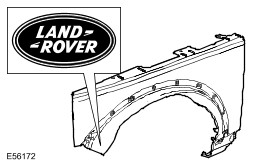
| If possible, the individual protective layers (zinc, cathodic base coat) on Land Rover bodywork components must not be damaged or destroyed by sanding or other mechanical operations. |
| The area to be ground should be kept as small as possible, the corrosion protection applied in production (cathodic primer) should be retained as much as is possible. |
| The welding primer must be stirred well or shaken before application. |
| The welding primer must be allowed to dry before welding is carried out. |

| The primer must be dry before sealing mastic or underbody protection is applied. Do not use thinners when applying sealing mastic (the mastic would not dry). |
| A flat scraper or a wire brush can be used instead of the rotating brush if the cavity is small. Do not use an angle grinder, which would weaken the structure. |
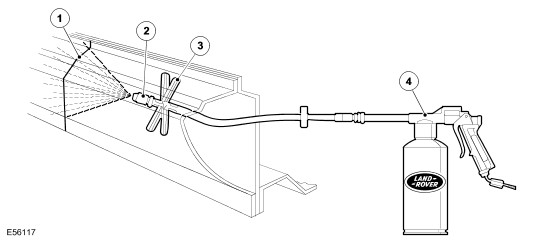
| 1 | - | Weld bead |
| 2 | - | Spray head |
| 3 | - | Distance maintainer |
| 4 | - | Spray gun |
| Corrosion protection method | Exterior surfaces | Accessible inner surfaces | Inaccessible inner surfaces |
|---|---|---|---|
| Painting | X | X | |
| Cavity protection | X |
| Corrosion protection method | Weld flanges before welding in place (contact surfaces) | All bare sanded areas | Weld flange area accessible | Weld flange area not accessible |
|---|---|---|---|---|
| Welding primer | X | |||
| Painting | X | X | ||
| Clinched flange protection | X | |||
| Cavity protection | X |
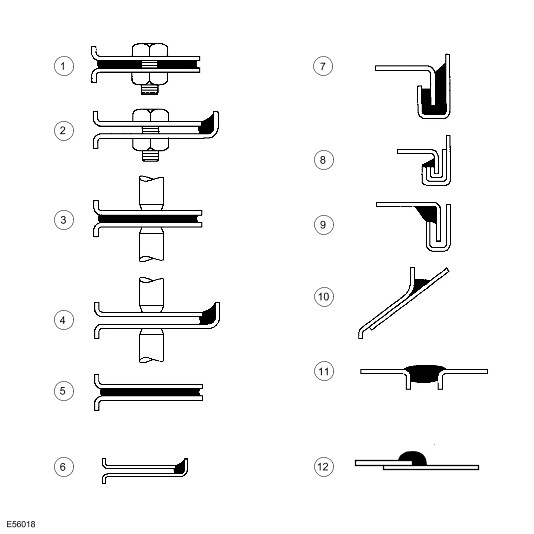
| 1 | Between Panels - Bolted | |
| 2 | Panel Edge Bolted | |
| 3 | Between Panels - spot welded | |
| 4 | Panel edges - spot welded | |
| 5 | Between panels - bonded | |
| 6 | Panel edges - bonded | |
| 7 | Clinch joints - type A | |
| 8 | Clinch joints - type B | |
| 9 | Clinch joints - type C | |
| 10 | Gaps between panels - type A | |
| 11 | Gaps between panels - type B | |
| 12 | Lap joint |
| Description - Usage | Supplier | Part Number |
|---|---|---|
| Cavity - Wax | - | - |
| Inner Cavity Wax (Amber) | 3M | 0890/11/21 |
| Inner Cavity Wax (Transparent) | 3M | 08909/19/29 |
| Cavity Wax | Croda | PW57 |
| Engine Bay Waxes/Lacquers | ||
| Astrolan Engine Bay Wax and Cosmetic Wax | Astors | DA3243/1 |
| Engine Bay and Cosmetic Wax/Lacquer | Croda | PW197 |
| Engine Bay Cosmetic Lacquer | Dinol | 4010 |
| Miscellaneous Materials | - | - |
| Aerosol Auto Adhesive (Trim) - impact Adhesive for trim Parts | 3M | 08080 |
| Flexible Parts Repair Material - rubber modified polypropylene parts | 3M | 05900 |
| Acoustic Foam (sika baffle 278) - expanding foam block repair | Sika | LR Part No AZL 500021. Ford Part No 6H22-11840-AA |
| Flexible Foam (anti - flutter) - between panels | Duramix | 4320 |
| Water Shedder Repair (Aerosol) | Teroson | - |
| Low Temperature Anti-Corrosion Coating (Magnesium) | Land Rover | VEP 501 840 PMA |
| Seam Sealers | ||
| Body Caulking - type (b) gaps between panels | 3M | 08568 |
| Drip Chek Clear - bolted, spot welded and bonded panel edges; type (a) and (b) gaps between panels; type ©) clinch joints | 3M | 08401 |
| Drip Chek Heavy - type (b) gaps between panels; type ©) clinch joints | 3M | 08531 |
| Polyurethane Seam Sealer - bolted, spot welded and bonded panel edges; type (a) and (b) gaps between panels; type (b) clinch joints | 3M | 08684/89/94 |
| Polyurethane Sealer (Sachet) - bolted panel edges; type (b) clinch joints | 3M | 08703/83/88 |
| Sprayable Sealer - lap joints | 3M | 08800/23 |
| Super Seam Sealer - lap joints; type (b) clinch joints | 3M | 08537 |
| Weld Thru' Sealer - between spot welded panels | 3M | 08626 |
| Betafill Clinch and Brushable Sealer - type (b) clinch joints | Gurit-Essex | 10211/15/20 |
| Clinch, Joint and Underbody Coating - lap joint | Gurit-Essex | 10101/10707 |
| Leak Chek Clear - between bolted panels; spot welded and bonded panel edges; type ©) clinch joints; type (a) gaps between panels | Kent Industries | 10075 |
| Putty - type (b) gaps between panels | Kent Industries | - |
| Polyurethane Seam Sealer - bolted, spot welded and bonded panel edges; between bonded panels; type (a) and (b) gaps between panels | PPG | 6500 |
| Polyurethane Seam Sealer - bolted, spot welded and bonded panel edges; between bonded panels; type (b) gaps between panels | Teroson | 92 |
| Terolan Light Seam Sealer - bolted, spot welded and bonded panel edges; between bonded panels; type (a) and (b) gaps between panels; between bonded panels; type ©) clinch joints | Teroson | - |
| Terolan Special Brushable Seam Sealer - lap joints | Teroson | - |
| Terostat Sprayable Seam Sealer - bolted, spot welded and bonded panel edges; between bonded panels; type (b) gaps between panels | Teroson | 9320 |
| Terostat 1K PU Seam Sealer (SE 20) - type (a) and (b) gaps between panels; spot welded and bonded panel edges | Teroson | - |
| Sealing Compound - bolted, spot welded and bonded panel edges; between bonded panels; type (b) gaps between panels | Wurths | 8901001/-/6 |
| Structural Adhesives | ||
| Automotive Structural Adhesive - between bonded panels; type (a) clinch joints | 3M | 08115 |
| Two Part structural Epoxy - between bonded and spot welded panels; type (a) clinch joints | Ciba-Geigy | XB5 106/7 |
| Underbody Sealers | ||
| Body-Schutz | 3M | 08861 |
| Spray-Schutz | 3M | 08877 |
| Crodapol Brushable Underbody sealer | Croda | PV75 |
| Terotex Underseal (CP02) | Teroson | 9320 |
| Underbody Waxes | ||
| Stone Chip Coating (smooth) | 3M | 08158/9 |
| Underbody Wax | Croda | PW61 |
| Underbody Wax | Dinol | Tectacote 205 |
| Weld - through Primers | ||
| Weld Thru' Coating | 3M | 05913 |
| Zinc Spray | 3M | 09113 |
| Zinc Rich Primer | ICI | p-565 634 |
 : Ensure that suspension units, wheels, tires, power unit, drive shafts,
exhaust and brakes (including all mounting points) are shielded prior to
application of fresh underbody sealer.
: Ensure that suspension units, wheels, tires, power unit, drive shafts,
exhaust and brakes (including all mounting points) are shielded prior to
application of fresh underbody sealer. |
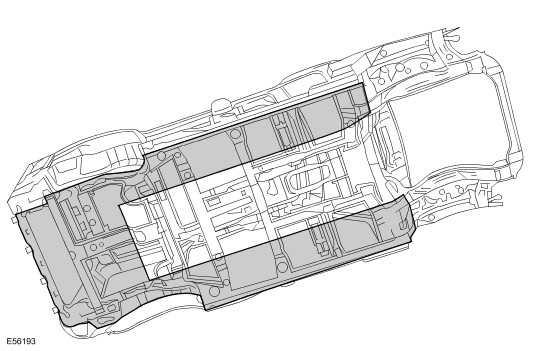
 : Do not remove wax or lacquer from underbody areas during repairs.
: Do not remove wax or lacquer from underbody areas during repairs.
|
 : Do not use oxy-acetylene to remove corrosion prevention material. Large
volumes of fumes and gases are liberated by these materials when they
burn.
: Do not use oxy-acetylene to remove corrosion prevention material. Large
volumes of fumes and gases are liberated by these materials when they
burn. |
 : When separating a joint with metal to metal adhesive, it is important to
avoid distortion. Heat gradually until the bond weakens sufficiently to
permit panel separation.
: When separating a joint with metal to metal adhesive, it is important to
avoid distortion. Heat gradually until the bond weakens sufficiently to
permit panel separation. |
| When spot welding through metal to metal adhesive, take particular care to adjust the equipment setting to ensure a suitable weld. |
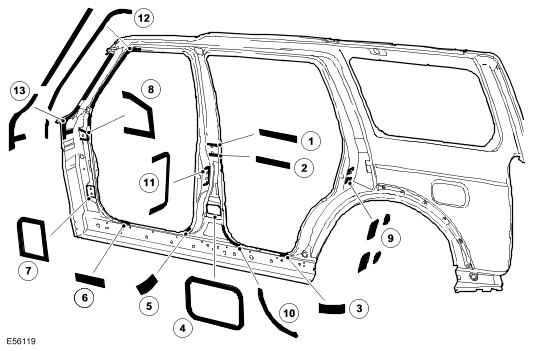
| Item | Application | Function |
|---|---|---|
| 1 | B-pillar upper hinge RH/LH | Structural |
| 2 | B-pillar upper hinge RH/LH | Structural |
| 3 | Rear rocker panel RH/LH | Structural |
| 4 | B-pillar lower hinge RH/LH | Structural |
| 5 | Front rocker panel RH/LH | Structural |
| 6 | Front rocker panel RH/LH | Structural |
| 7 | A-pillar lower hinge RH/LH | Structural |
| 8 | A-pillar upper hinge RH/LH | Structural |
| 9 | C-pillar striker reinforcement | Structural |
| 10 | B pillar rear door aperture | Structural |
| 11 | B-pillar latch face | Structural |
| 12 | A-pillar to front door aperture | Structural |
| 13 | A-pillar to W/shield aperture | Structural |
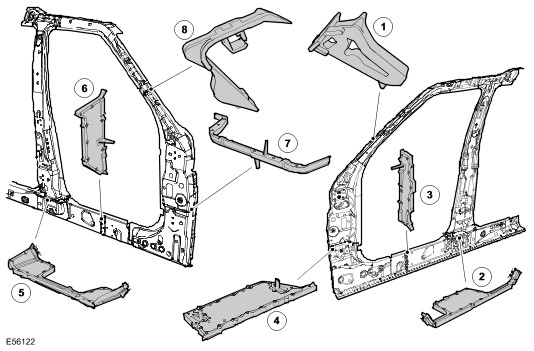
| Item | Description | Function | Service part No |
|---|---|---|---|
| 1 | A-pillar upper inner | Acoustic | EUH000520 |
| 2 | B-pillar lower inner | Water Ingress/Acoustic | EUH000560 |
| 3 | Rocker panel middle | Acoustic | EUH000670 |
| 4 | A-pillar lower inner | Water Ingress/Acoustic | EUH000550 |
| 5 | B-pillar lower outer | Water Ingress/Acoustic | EUH000570 |
| 6 | Rocker panel outer | Acoustic | EUH000680 |
| 7 | A-pillar lower inner | Water Ingress/Acoustic | EUH000540 |
| 8 | A-pillar upper outer | Acoustic | EUH000530 |
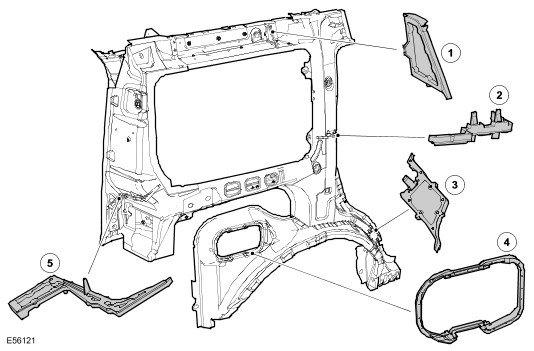
| Item | Description | Function | Service part No |
|---|---|---|---|
| 1 | Cantrail rear | Acoustic | EUH000650 |
| 2 | C-pillar outer | Acoustic | EUH000610 |
| 3 | Rear wheel arch outer | Water Ingress/Acoustic | EUH000590 |
| 4 | Fuel filler aperture | Water/Fuel Ingress | ARY 780030 |
| 5 | D-pillar outer | Acoustic | EUH000630 |
